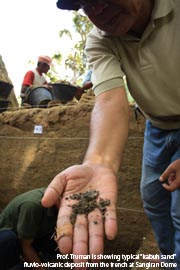Center for Prehistory and Austronesian Studies
© created by The Expendable Scientists Corp., 2013

AIMS & OBJECTIVES
Center of Prehistory and Austronesian Studies as a non-profit non-governmental research institution aims to assist both Indonesian government and public in understanding the origins and complexity of early Indonesian cultures, as well as its dynamics through periods of times. We are also aiming to be the leading institution in conducting multi-disciplinary researches related to prehistory and Austronesian issues, excavations, and/or socialisation of heritage values on prehistory and Austronesia, both in Indonesia and internationally.
Main objectives of Center of Prehistory and Austronesian Studies are:
SCOPE OF RESEARCHES AND FIELDS OF STUDIES
Prehistory in Indonesian context spans more than 1.5 million years and almost absolutely dense with dynamics of human activities, environmental aspects, as well as variety of cultures. The dynamics within this area began to develop to a more complex ones especially 4000 years ago, when Austronesian speakers first arrived in the Archipelago and thus believed to become today’s population of Indonesian people. The arrival of Austronesian speakers is thought to be a valuable asset in comprehensive history of humanity and civilisation; and is thought to be important not only to nation-wide necessity, but also within the region of Southeast Asia as well as globally.
During this wide span of lifetime, values of cultural wisdom and characteristics began to develop in every corner of Indonesian Archipelago. Most of these values are considered to be hidden gems, waiting to be (re)discovered and explored by today’s generation. Various researches and fields of study regarding the issue of Indonesian prehistory, Austronesian speakers, and their cultural-environmental dynamics shall include essential problematic such as:
Examples of issues may be addressed in nation-wide, regional, and global context are:
Center of Prehistory and Austronesian Studies as a non-profit non-governmental research institution aims to assist both Indonesian government and public in understanding the origins and complexity of early Indonesian cultures, as well as its dynamics through periods of times. We are also aiming to be the leading institution in conducting multi-disciplinary researches related to prehistory and Austronesian issues, excavations, and/or socialisation of heritage values on prehistory and Austronesia, both in Indonesia and internationally.
Main objectives of Center of Prehistory and Austronesian Studies are:
- To conduct researches related to prehistoric and human, culture, and environmental studies in Indonesian Archipelago; to conduct researches related to the culture and environmental evolution of Austronesian speakers; to gather primary data, artefacts, and contextual analyses related to the subjects in hand
- To organise publication and socialisation of such researches and current results
- To offer consultancy relating to cultural heritage issues spanning from prehistoric period through the early settlement of Indonesian Archipelago
- To actively involve in the development of prehistory and Austronesian studies through publication, lectures, and didactic activities
- To participate on maintaining public appreciation towards prehistoric remains and their heritage values
- To use our best effort in establishing and managing wide international networks and professionalship in order to provide more comprehensive results
SCOPE OF RESEARCHES AND FIELDS OF STUDIES
Prehistory in Indonesian context spans more than 1.5 million years and almost absolutely dense with dynamics of human activities, environmental aspects, as well as variety of cultures. The dynamics within this area began to develop to a more complex ones especially 4000 years ago, when Austronesian speakers first arrived in the Archipelago and thus believed to become today’s population of Indonesian people. The arrival of Austronesian speakers is thought to be a valuable asset in comprehensive history of humanity and civilisation; and is thought to be important not only to nation-wide necessity, but also within the region of Southeast Asia as well as globally.
During this wide span of lifetime, values of cultural wisdom and characteristics began to develop in every corner of Indonesian Archipelago. Most of these values are considered to be hidden gems, waiting to be (re)discovered and explored by today’s generation. Various researches and fields of study regarding the issue of Indonesian prehistory, Austronesian speakers, and their cultural-environmental dynamics shall include essential problematic such as:
- General reconstruction of prehistoric life within the Indonesian Archipelago;
- General reconstruction of lives of Austronesian people since they first arrival and their legacy today;
- How human first arrived in the Archipelago, how did they adapt themselves to the local environment, and how they had managed to survive for millions of years;
- How far does environmental and its evolutionary processes affected the variety and development of cultures;
- How did they managed to travel across islands and dispersed into wide range of area;
Examples of issues may be addressed in nation-wide, regional, and global context are:
- First colonisation of prehistoric human in Indonesia and Southeast Asia;
- The extinction of Homo erectus and emergence of anatomically modern human (AMH)
- Impacts of climate and ecology in the Last Glacial period to the development of human occupation and cultures;
- Ethnogenesis of Indonesian people related to the dispersion and development of Austronesian population;
- Pluralism and multiculturalism from prehistoric to present times;
- Local innovations and emerging cultures in prehistory;
- Tendencies of population and cultural growth in present and future Southeast Asia in global context;
- Contributions of prehistoric culture and tradition to present day cultures.


Vision